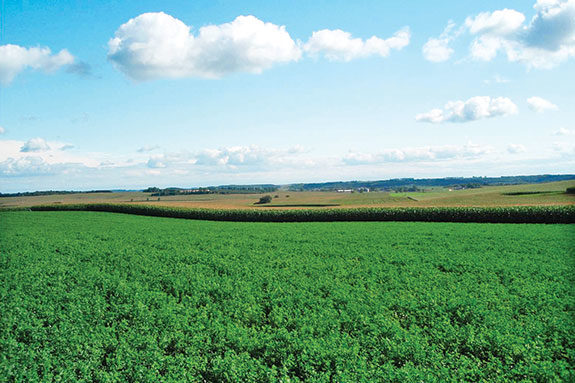For example, over 15 years on a silt loam soil in southwestern Wisconsin with fertilizer nitrogen (N) applied at rates high enough to maximize corn yield in all crop rotations, researchers from the University of Wisconsin found that yield was 19 percent (27 bushels per acre) higher for first-year corn after alfalfa than continuous corn, while second-year corn after alfalfa and corn after soybean yielded similarly and 10 percent (16 bushels per acre) higher than continuous corn.
In comparison, over 26 years on a loam soil in northeastern Iowa with fertilizer N rates sufficient for maximum yield, researchers from Iowa State University found highest yields with first-year corn after alfalfa and corn following soybean, intermediate yields with second-year corn after alfalfa and lowest yields with continuous corn and second-year or third-year corn following soybean.
Conversely, high water removal by alfalfa can reduce the yield of the following corn crop in dry years if there is insufficient recharge of water in the soil profile during the fall or spring prior to corn.
Another benefit from alfalfa is the N that is supplied to the following corn crops. When compared to continuous corn, guidelines from universities in the Upper Midwest suggest that fertilizer N needs following the termination of a good stand of alfalfa (at least four plants per square foot) can generally be reduced by up to 100 percent for first-year corn and by up to 50 percent or more for second-year corn.
These N credits from alfalfa to corn are largely the result of N-rich inputs to the soil organic matter pool.
These inputs which include alfalfa leaves and stems lost during harvest, alfalfa stand losses over time, turnover of thin alfalfa roots and exudation of substances from alfalfa roots, can rapidly mineralize after alfalfa stand termination and release N for at least two years.
Previous research in the northern U.S. found that the grain yield of first-year corn following alfalfa was not increased with fertilizer N in 91 percent of 140 fields.
These fields had good alfalfa stands at the time of termination, were in alfalfa production for at least one full year prior to termination, were typically terminated in the fall with tillage and generally had deep soils with medium to fine texture.
Fields with the most frequent N response tended to have fine-textured soils that were inadequately drained or coarse-textured soils, coupled with excess rainfall between the time of alfalfa termination and early-season corn growth.
To determine whether alfalfa N credit guidelines for first-year corn still apply with contemporary, high-yielding corn crops, we conducted research on 32 farms across Minnesota and western Wisconsin from 2009 to 2011.
The first study evaluated the response of first-year corn yield to fertilizer N applied near planting on five farms in 2009 and on five farms in 2010 that had good alfalfa stands at the time of termination and medium-textured to fine-textured soils.
First-year corn yield averaged over 195 bushels grain per acre on seven of the 10 farms and over 24 tons silage per acre on seven of the nine farms where it was measured, yet first-year corn grain and silage yields were not increased when fertilizer N rates up to 160 pounds N per acre were applied.
On seven of these 10 farms, residual soil nitrate-N was measured to a depth of four feet in the fall after corn harvest.
Results showed minimal increase in residual soil nitrate-N when 40 pounds N per acre was applied near planting, likely due to luxury consumption by the corn crop.
However, residual soil nitrate-N increased rapidly when more than 40 pounds N per acre was applied. A high amount of residual soil nitrate-N remaining after harvest is a concern because the N is susceptible to loss through leaching and denitrification.
The second study that we conducted evaluated the response of first-year corn to fertilizer N and whether this was affected by the amount of alfalfa regrowth in the fall and the timing of tillage (disk-chiseling) for alfalfa termination.
This research was conducted on six farms in southern and central Minnesota in 2010 with medium-textured to fine-textured soils and good alfalfa stands at the time of termination.
Surprisingly, the presence of fall alfalfa regrowth did not affect first-year corn grain or silage yields or their response to fertilizer N applied near planting (0 to 160 pounds N per acre), even though this alfalfa regrowth averaged 11 inches with 33 pounds N per acre across the six farms.
Similarly, there was no effect of tillage timing on first-year corn grain and silage yields. These results indicate that growers should harvest alfalfa regrowth in the last year on medium-textured to fine-textured soils with good alfalfa stand densities – and that growers have some flexibility in tillage timing when terminating alfalfa.
In this study, first-year corn grain yield responded to fertilizer N at only one of six farms, even with average yields of 180 to 231 bushels per acre.
On the one responsive farm where 70 to 81 pounds N per acre was needed to economically optimize grain yield, there was fine-textured soil, abundant early-season rainfall and inadequate drainage, which likely slowed N mineralization due to low oxygen levels in the soil.
However, across all farms fertilizer N was needed (42 to 64 pounds N per acre) to economically optimize corn silage yield, even though silage yield was increased by just 3 percent with N.
In 2010 and 2011, we conducted a third study on seven no-till farms across southern Minnesota and western Wisconsin to evaluate the response of first-year, no-tillage corn grain and silage yields to fertilizer N applied near planting (0 to 160 pounds N per acre).
These farms had medium-textured to fine-textured soils and good alfalfa stands at the time of alfalfa stand termination and the cooperating farms applied a small amount of starter fertilizer N at planting.
Grain yield on these seven farms averaged 199 to 220 bushels per acre and silage yield averaged 21.1 to 30.3 tons per acre on the four farms where it was measured, yet grain and silage yields were not increased with fertilizer N.
On one of these farms with clay loam soil in southwestern Minnesota, we also compared no-till with fall disk-chiseling but found no differences in grain yield or its response to fertilizer N.
In 2011, a fourth study was conducted on nine farms in southern and central Minnesota with medium-textured to fine-textured soils and good alfalfa stands at the time of termination with tillage.
In this study, we evaluated the response of corn grain yield to fertilizer N applied near planting or as a sidedress application when corn was at the six-leaf collar stage.
Grain yield was increased with fertilizer N on just three of these nine farms. When fertilizer N was applied near planting, the economically optimum N rate was 40 pounds N per acre on one farm and 80 pounds N per acre on two farms, but equivalent yields were obtained on these farms with just a sidedress application of 40 pounds N per acre.
Response to fertilizer N on these three farms in 2011 was likely related to above-average early-season precipitation and low oxygen levels in the soil that limited mineralization of N.
Take-home points for first-year corn after alfalfa
• Increased yield potential compared to other crop rotations.
• If possible, harvest alfalfa regrowth in the fall before stand termination, especially if the stand density is good.
• No-till can work well for first-year corn, even on fine-textured soils.
• On medium-textured to fine-textured soils with good alfalfa stands at termination, first-year corn grain yield was increased with fertilizer N on only four of 32 farms (13 percent of the time).
• It may be more common for silage corn to respond to a small amount of N than grain corn.
• Soil nitrate-N after harvest can increase greatly if rates above 40 pounds N per acre are applied to first-year corn and if N is not needed to optimize yield.
• The chance of first-year corn responding to N can increase if there is significant rainfall between alfalfa termination and early-season corn growth on fine-textured soils that are inadequately drained or on sandy soils.
• If one anticipates that fertilizer N is needed for first-year corn after alfalfa, consider a small amount of N in a starter fertilizer or consider a small sidedress application (around 40 pounds N per acre) depending on early-season growing conditions rather than a high N rate applied near planting. FG
Matt Yost is from the University of Minnesota and Michael Russelle is from the USDA–Agricultural Research Service.

Jeff Coulter
Extension Agronomist
University of Minnesota











